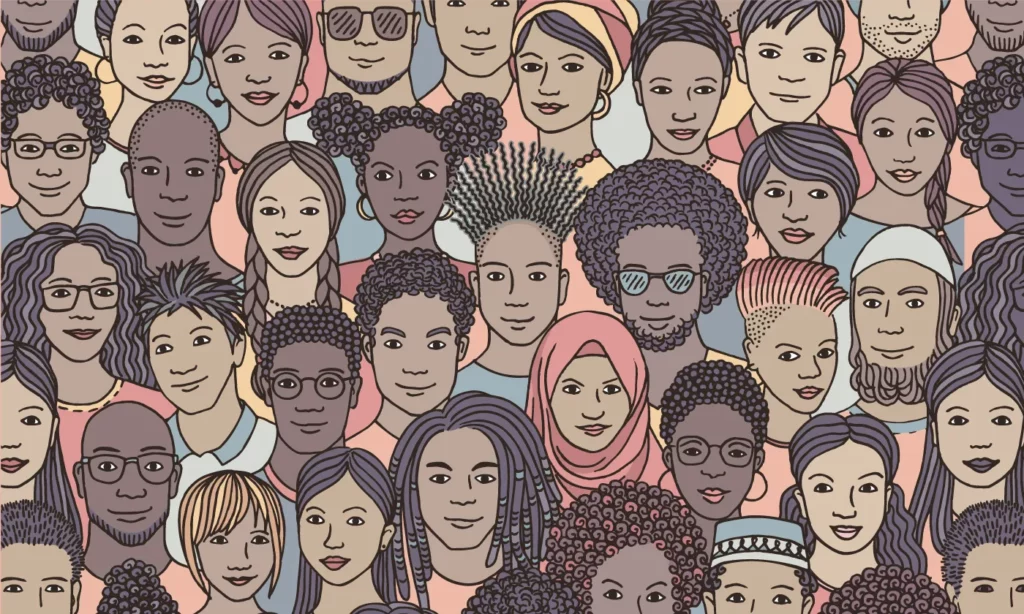
Photo: Franzi Draws/Adobe
Data shows that the nonprofit sector experiences higher turnover rates than the for-profit sector and the largest turnover was with Black, Indigenous, (and) People of Color (BIPOC) staff.
According to the Nonprofit HR 2022 Retention Survey, in 2021, nonprofits experienced an annual turnover rate of 24%, with 20% being voluntary turnover. When this turnover is broken down by race and ethnicity, 29% of organizations reported having the most challenge with retaining BIPOC employees and 14% of organizations reported having the most challenge with retaining individuals of two or more races. By career level, 48% of organizations reported experiencing the most challenges retaining entry-level staff and 40% of organizations reported experiencing the most challenges retaining mid-level staff. In the most shocking (yet not shocking) revelation from this study, respondent organizations reported that only 21% of organizations have a formal retention strategy.
These statistics paint a clear picture: while many nonprofits experience challenges retaining BIPOC staff, relatively few have a formal retention strategy. This is an incredibly costly decision to make. If organizations fail to retain their talent, they’ll need to hire new talent—and the direct cost of hiring new talent is estimated at $4,700, and indirect costs (i.e., recruiting, impact on productivity, etc.) can be more expensive and have been estimated to be three to four times of the annual salary. Retaining talent is financially beneficial to the organization. So, let’s discuss ways organizations can retain their staff.
Retention strategies fall into four categories: people, operations, career development, and compensation.
People
People are the backbone of any organization, so it’s important to focus on the well-being of people and ensure they feel supported. Here are some ways organizations can be intentional about supporting people to help increase retention:
- Reduce Black employee burnout. There are many causes for burnout, but the one we want to highlight here is the burnout that happens when Black employees are constantly forced to code-switch; this causes an incredible psychological toll on Black employees. Even though the costs of code-switching are high, Black employees are often forced to code-switch to increase their chances of hiring, promotion, etc.[1]
- Although not a complete solution in itself, one way to curb burnout is implementing a sabbatical policy.
- Engage equitably. This includes checking in with staff equitably—do not play favorites with team members—and engaging BIPOC team members in important working groups, defined as groups that are tasked with making decisions or changes that impact and/or shape the whole organization, without tokenizing, taking advantage, or over-relying on or burdening of BIPOC team members.
- Implement Indigenous cultural sensitivity trainings. Educating non-Indigenous staff on Indigenous culture and how these cultural traits and values manifest at work can lead to a more inclusive culture and Indigenous staff feeling supported and respected because their colleagues/supervisors better understand how they work.
- Culturally accommodate Indigenous employees. This can be done by creating and implementing policies specific to Indigenous employees—for example, understanding that bereavement time and expectations for Indigenous people may look different and creating policies that accommodate these expectations (i.e., allow additional time for various traditions, ceremonies, etc.).
- Praise staff members for a job well done. Ultimately, people want to feel valued. Remember, not everyone likes receiving praise the same way: for example, some people love shout-outs in a group meeting, while others prefer receiving praise in a one-on-one setting. Rather than assuming how people like to receive praise, ask them.
Operations
The operations of an organization not only ensure organizational functions run smoothly, but they (policies, practices, and systems) can also foster a positive, healthy work environment. The following ways are deliberate steps organizations can implement to support BIPOC staff:
- Be deliberate about onboarding and integration. Onboarding isn’t only about having new hires complete the necessary paperwork: it’s also a vital opportunity for new hires to learn about the ins and outs of their organization. This includes learning about the organization’s culture. For example, BIPOC staff may want to know in what ways the organization is inclusive and supportive, if the organization is aware BIPOC staff are often impacted by biases and microaggressions and has policies in place to combat these biases and microaggressions, if BIPOC staff are in leadership positions, how the organization defines “professionalism,” if the organization fosters a space in which BIPOC employees don’t need to code-switch, and other key concerns.
- Embrace hybrid and/or full-time remote work options. The Future Forum’s Remote Employee Experience Index found that 97% of Black employees want a hybrid or remote-only workplace model, compared to 79% of white employees. Additionally, Black employees experienced a higher sense of belonging, better work-life balance, and an increased ability to manage stress in a remote work setting compared to their white peers. This can be attributed to the fact that Black employees may face fewer situations of discrimination and microaggressions, need to code-switch less, and experience an “improved ability to ‘bounce back’ from incidents.”
- Support the creation of Employee Resource Groups, or ERGs. ERGs can create a sense of belonging for BIPOC staff. They can also help leadership learn about the pain points, which can be addressed by leadership.
Career Development
Career development is an important aspect of one’s career and can heavily impact whether an employee stays at their present company—according to a research report released by SHRM, 76% of respondents said they are more likely to stay at a place of employment that provides ongoing training. It’s clear that focusing on career development is an organization’s best interest, so here are some ways organizations can support the development of their staff:
- Invest in professional development. Staff members who receive ample professional development opportunities are 15% more engaged and have a 34% higher retention rate than those not offered these opportunities. Professional development includes, but is not limited to, a professional development stipend, organization-wide trainings, stretch projects, and constructive feedback. Stretch projects give staff an opportunity to gain new skills and knowledge, and they will feel challenged. In terms of feedback, create a culture of giving regular constructive feedback, rather than doing so annually.
- Create advancement opportunities for BIPOC staff. One of the primary reasons for voluntary turnover is lack of career growth, and coupled with the fact that the uncontrolled pay gap for Black women is very high—because Black women are massively underrepresented in higher-paying positions and industries—organizations need to increase the leadership opportunities. [2] Not only will this support the reduction of the uncontrolled pay gap, but it will also directly address one of the primary reasons for voluntary turnover.
- Establish a mentorship program for BIPOC staff. The positive impacts of mentorship programs are ample: they provide direct support; create intentional space for learning; foster growth; increase the likelihood of promotions (mentees are promoted five times more frequently than individuals who don’t have a mentor and mentors are six times more likely to be promoted than those who are not mentors), which support career growth (see above); and, decrease the likelihood of leaving.
Compensation
Employees who are paid equitably and competitively are more likely to stay at a nonprofit than employees who are not. Here are some compensation-related ways that organizations can mitigate turnover:
- Consider total compensation. Total compensation includes cash compensation (i.e., salary and bonuses) as well as monetary and non-monetary benefits, like health insurance, PTO, sabbaticals, professional development, and others. Organizations should create total compensation statements for employees. This will give staff a clear idea of how much the organization is investing in them and the full value that the staff member receives from the organization.
- If financially feasible, offer wellness benefits. As mentioned above, Black employees can experience psychological workplace impacts from code-switching, microaggressions, and other bias-related issues, so offer wellness benefits, which can include wellness stipends, paid mental health/wellness days, etc.
- Ensure compensation is internally and externally equitable. Internal compensation equity refers to how employees are compensated compared to other employees with a similar level of responsibility at their organization. External compensation equity refers to how employees are compensated compared to other, similar positions at different yet similar organizations. It’s best practice to conduct pay equity audits every 2-3 years. In between those years, ensure staff are receiving COLA increases.[3]
- Consider benefit benchmarking: although less common than salary benchmarking, benchmarking your benefits gives organizations insight into the types of benefits being offered at your organization compared to peer organizations, as well as how competitive the benefits are compared to the market.
It is crucial for organizations to have a retention strategy that includes a mix of people, operations, career development, and compensation-related policies and practices. It is important to note that none of these approaches, in isolation, are the answer to increasing BIPOC retention. It is about creating an intentional, holistic strategy that is focused on treating BIPOC staff well. If you or your organization wants support designing and implementing a retention strategy, reach out to DRG Talent. Our expertise includes designing and assessing retention strategies, which include (but are not limited to) compensation analysis and strategies, benefits design, professional development design, and onboarding and integration plans. To discuss these services, please contact our expert, Akshita Sankepally (asankepally@drgtalent.org).
[1] There are many nuances to code-switching, and I (the author) do not pretend to understand all the aspects of code-switching for Black individuals as an Indian person.
[2] The uncontrolled pay gap compares the median salaries of all workers by demographic categories (i.e., race, sex, age, etc.) regardless of occupation and industry.
[3] DRG recommends using the Consumer Price Index, released by the U.S. Bureau of Labor, to determine COLA.

